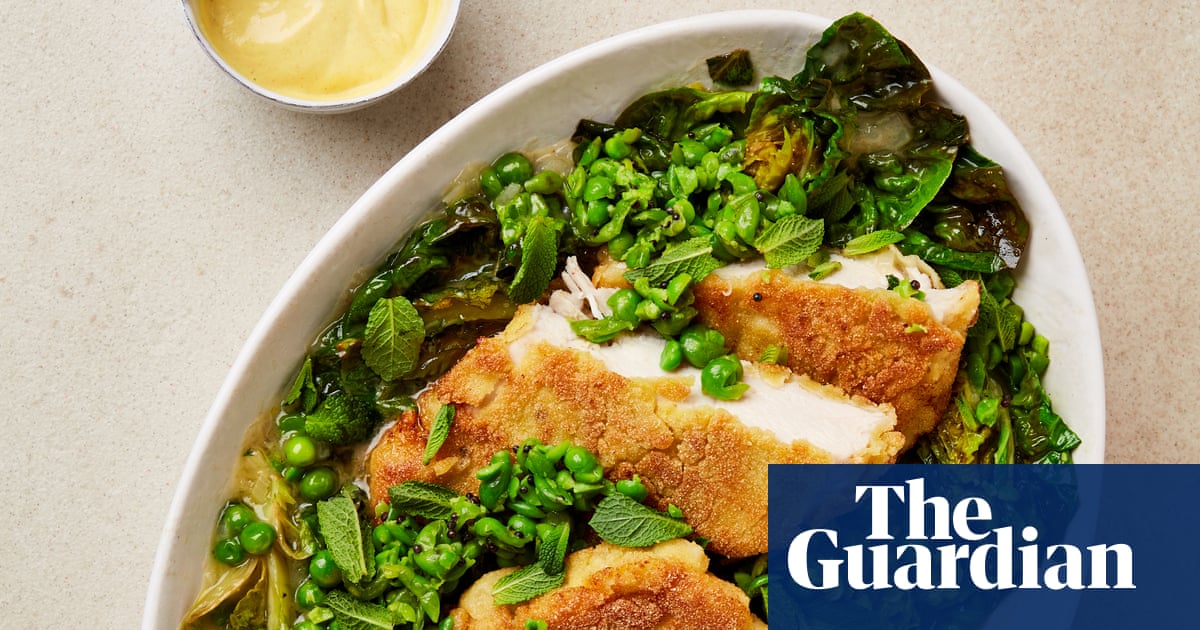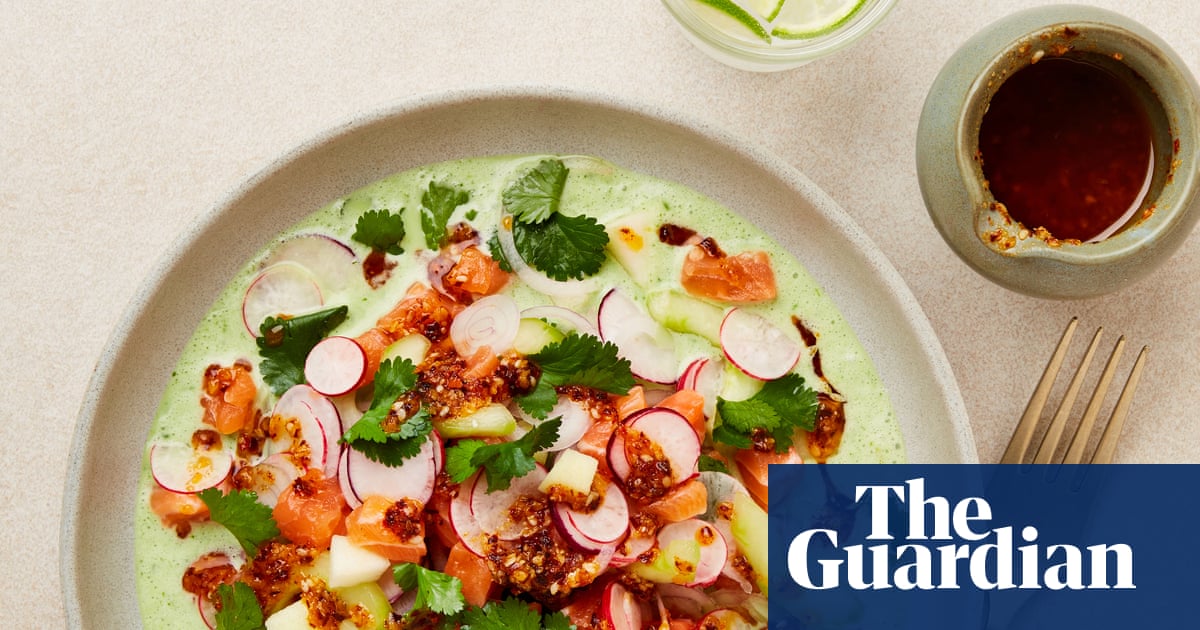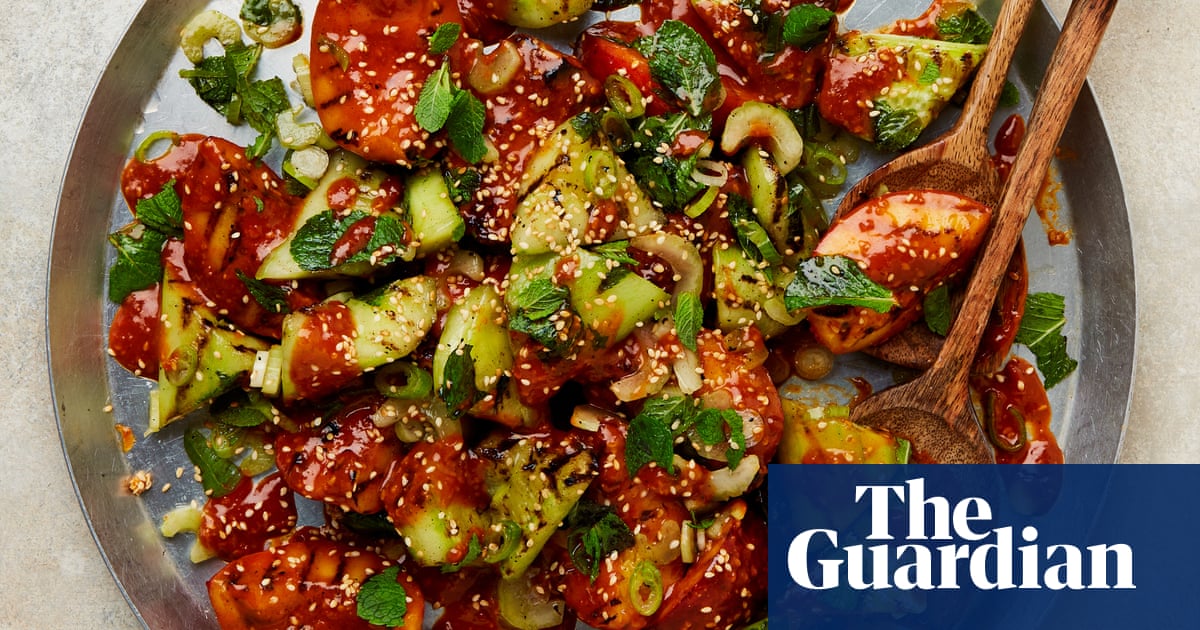
Many of my favourite comfort foods are connected by one ingredient: semolina. Whether it’s the gnocchi my Italian grandmother made for us or the syrup-drenched cakes, dumplings and couscous of my childhood in Jerusalem, it’s often semolina at work. Its texture is distinct: somehow glutinous and gritty in the likes of those gnocchi, but also light and sandy in cakes and cookies. Semolina, which is halfway between wheat and flour, is also a really effective way to bring a welcome crunch to two other great comfort foods: roast potatoes, which benefit hugely from being rolled in a little semolina after they’ve been parboiled, and chicken schnitzel. In fact, it’s a bit of a miracle ingredient.
Mustardy chicken schnitzel with braised peas and pea salsa (pictured top)
Here, semolina makes a light and crisp crust for a comforting schnitzel. Both the braised peas and the pea salsa can be made the day before.
Prep 15 min
Cook 45 min
Serves 2
For the salsa
90ml olive oil
1 tsp black mustard seeds
80g frozen peas or petit pois, plus 150g extra for the braised peas
Fine sea salt and black pepper
For the braised peas
60g unsalted butter
2 large shallots, peeled, halved and roughly chopped (110g)
1 baby gem lettuce, cut into 6 wedges
2 anchovy fillets in oil, drained and roughly chopped
50g plain flour, plus 1 tbsp extra
200ml chicken stock
For the schnitzels
150g fine semolina
1 medium egg, beaten
2 tbsp dijon mustard, plus extra to serve
2 tbsp wasabi paste
2 chicken breasts, skinless (400g)
10g mint leaves, roughly chopped
Put two teaspoons of oil in a medium saucepan on a medium heat, add the mustard seeds and cook for two minutes, until they start to pop. Take off the heat, stir in 80g of the peas and leave to cook in the residual heat. Transfer to a mortar, add a quarter-teaspoon of salt, then crush gently and put to one side.
For the braised peas, return the saucepan to a medium heat and add the butter. Once it’s melted, add the shallots and half a teaspoon of salt and cook, stirring occasionally, for two minutes, until slightly softened. Add the remaining 150g peas, the lettuce wedges and the anchovies, and cook for a further five minutes, until softened. Add a tablespoon of flour, stir for a minute, then pour in the stock. Turn the heat to low and leave to braise for 10 minutes, until nicely thickened. Set aside.
Put the remaining 80ml olive oil in a large frying pan on a medium-high heat. Put the flour and semolina in two separate wide, shallow bowls. Mix the egg, mustard and wasabi in a third shallow bowl. Put the chicken breasts on a board and, using a meat mallet (or the base of a small heavy saucepan), gently bash them to about 2cm thick. Sprinkle lightly with salt and pepper, then, one by one, coat first in flour, then in the egg mixture and finally in the semolina, shaking off the excess as you go.
Carefully lay one piece of chicken in the hot oil, fry, turning once halfway, for three minutes, until nicely browned all over. Transfer to a plate lined with kitchen paper to drain, then and repeat with the second coated chicken breast. Leave to rest for a minute or two, then cut each breast in half.
Stir two-thirds of the mint into the braised peas, then pour into a lipped platter and arrange the chicken on top. Garnish with the salsa, sprinkle over the remaining mint and serve with extra dijon mustard on the side.
Semolina idli with coconut chutney and spiced oil
Idli are soft, pillowy cakes from south India that are often made with lentils or rice flour, though this one features semolina. They’re usually made in specially designed moulds, but I use a cake tin to make life easier; you could also use lightly oiled round moulds or ramekins. Serve as a snack, for breakfast or as part of a larger spread at any time of day.
Prep 25 min
Cook 30 min
Serves 4-6
For the idli
200g fine semolina
30g desiccated coconut
250g Greek-style yoghurt
3 tbsp fresh lemon juice (ie, from 1-2 lemons)
Fine sea salt
½ tsp bicarbonate of soda
For the chutney
115g fresh coconut, roughly chopped
30g fresh coriander
120g Greek-style yoghurt
1 garlic clove, peeled and crushed
1 green chilli (10g), roughly chopped (remove and discard the pith and seeds if you prefer less heat)
1 tbsp fresh lime juice (ie, from 1 lime)
For the spiced oil
3 tbsp olive oil, plus 1 tbsp extra for greasing
20g pine nuts
10g white sesame seeds
10 fresh curry leaves
1 tsp black mustard seeds
1½ tsp aleppo chilli flakes, or mild chilli flakes
¼ tsp ground kashmiri chilli
First, make the idli batter. Put the semolina, desiccated coconut, yoghurt, lemon juice and 210ml cold water in a medium bowl, add three-quarters of a teaspoon of salt, mix well, cover with a plate and leave for 10 minutes.
Meanwhile, make the chutney. Put the fresh coconut, coriander, yoghurt, garlic, green chilli, lime juice and a third of a teaspoon of salt in the small bowl of a food processor, blitz until almost smooth and vibrant green, then scrape into a small bowl.
Grease a 22cm round cake tin and line it with baking paper. Half-fill a steamer with water and bring to a rolling boil. Quickly stir the bicarb into the batter, then pour it into the tin, put it in the steamer and cover (the batter will start to bubble, so make sure you work quickly). Turn down the heat to medium and steam for 22-24 minutes, until the middle of the idli is set. Take off the heat, uncover and set aside forfive minutes. The top of the idli will initially look rather wet, but it will steam dry very quickly.
To make the spiced oil, pour the oil into a small frying pan on a medium heat, add the pine nuts and sesame seeds, and fry, stirring now and then, for two to three minutes, until lightly toasted. Stir in the curry leaves, cook for 30 seconds to a minute, until the leaves turn translucent, then take off the heat and stir in the mustard seeds, the chilli flakes and ground chilli, and an eighth of a teaspoon of salt.
Run a knife all around the edge of the idli and put a large plate on top. Quickly invert to release the idli from the tin, then cut into eight wedges. Spoon over half the oil and serve with the rest of the oil and the chutney in bowls on the side for dipping.
Lemony semolina and almond cookies
These biscuits showcase the texture of semolina when it’s used in baking: they’re somehow light but weighty all at the same time. Once made, they’ll keep in the biscuit tin for up to a week.
Prep 5-10 min
Cook 30 min
Makes 19
50g flaked almonds, lightly broken in a mortar
85g golden caster sugar
100g room-temperature unsalted butter, cut into 1cm cubes
1 tbsp soured cream
1 egg
1 tsp vanilla bean paste
1 tsp lemon zest
140g fine semolina
75g ground almonds
2 tbsp cacao nibs
Fine sea salt
Heat the oven to 180C (160C fan)/350F/gas 4, and put the bashed flaked almonds in a medium bowl.
Put the sugar and butter in the bowl of a stand mixer fitted with the paddle attachment, then beat for 30 seconds, until pale and fluffy. Add the soured cream, egg, vanilla and lemon zest, and mix for a few seconds until well incorporated – don’t worry if it seems split: that’s all part of the plan.
Mix in the semolina, ground almonds, cacao nibs and a quarter-teaspoon of salt, and work with your hands until it comes together into a dough, taking care not to overwork it. Divide the dough and work it into 19 small balls weighing roughly 25g each. Working one by one, lightly roll each ball through the broken almonds, so they stick to the outside, then arrange them 2cm apart on a large oven tray lined with greaseproof paper. Bake for 22 minutes, until lightly golden and slightly firmed, then remove and transfer to a rack to cool completely.












